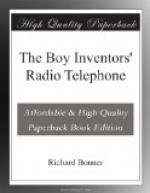Although they were making a high rate of speed, they hardly seemed to be moving as they soared in long circles. To get a sense of rapid motion, stationary objects must be in sight. In the lonely air it was hard to tell that they were moving at all except by looking down at the earth which, as they rose, appeared to be rushing from them, as if it were sinking through space.
But novel as all these sensations would be to an aerial novice, they were an old story to the boys. Jack devoted his attention to testing a new steering appliance he had equipped the craft with, and Tom watched his engines with an eagle eye to detect a skip or a “knock.”
“How high now?” asked the young engineer after an interval.
Jack glanced at the barograph on the dashboard in front of him.
“Three thousand feet,” he said.
“Might as well connect the alternator?” said Tom interrogatively.
Jack nodded, and Tom threw a lever which brought the generator of high frequency currents in contact with the motor by means of a friction fly-wheel. The alternator began to buzz and spark, crackling viciously.
A sort of metal helmet with two receivers attached to it, one on each side, lay handy at Jack’s hand. In front of him was the transmitter joined to the metal box which contained the microphone, transformers and inductance tuning coil. Tuning in the aerial apparatus was effected by means of a small knob projecting through a slit in the metal box enclosing the delicate instruments including the detector. By working this knob the tuning block was moved up and down the coil till a proper “pitch” was obtained.
Jack experienced an odd thrill as he prepared to send the first spoken word ever exchanged between an airship in motion and a station on land. He and Tom had sent plenty of wireless messages while soaring through the ether, but somehow, the dot and dash system had not half the fascination and mystery of the possibility of exchanging coherent speech between land and air.
He placed his lips close to the receiver, and with his hand on the tuning knob sent forth a loud, clear hail:
“Hullo, High Towers!”
There was no answer for a few seconds while he patiently adjusted the tuning knob. But then came a faint buzz like the humming of a drowsy bee. Suddenly, sharp and distinct, as if his father was at his elbow, came Mr. Chadwick’s voice in reply:
“Hullo!”
“This is the Wondership. Three thousand feet in the air,” cried Jack.
“Congratulations, my boy. It’s a success so far.”
“What shall we do now?” asked Jack.
“I want you to fly in the direction of Rayburn, and try to keep in communication all the way.”
“All right, dad,” responded Jack, and altered the course of the Wondership.
Rayburn was a small village some twenty-five miles to the north of Nestorville. Jack kept the receivers on his ears as he flew along. From time to time he exchanged conversation with his father. So far everything appeared to be working as if there were no limit to the distance over which the voices from the air and land could converse.




